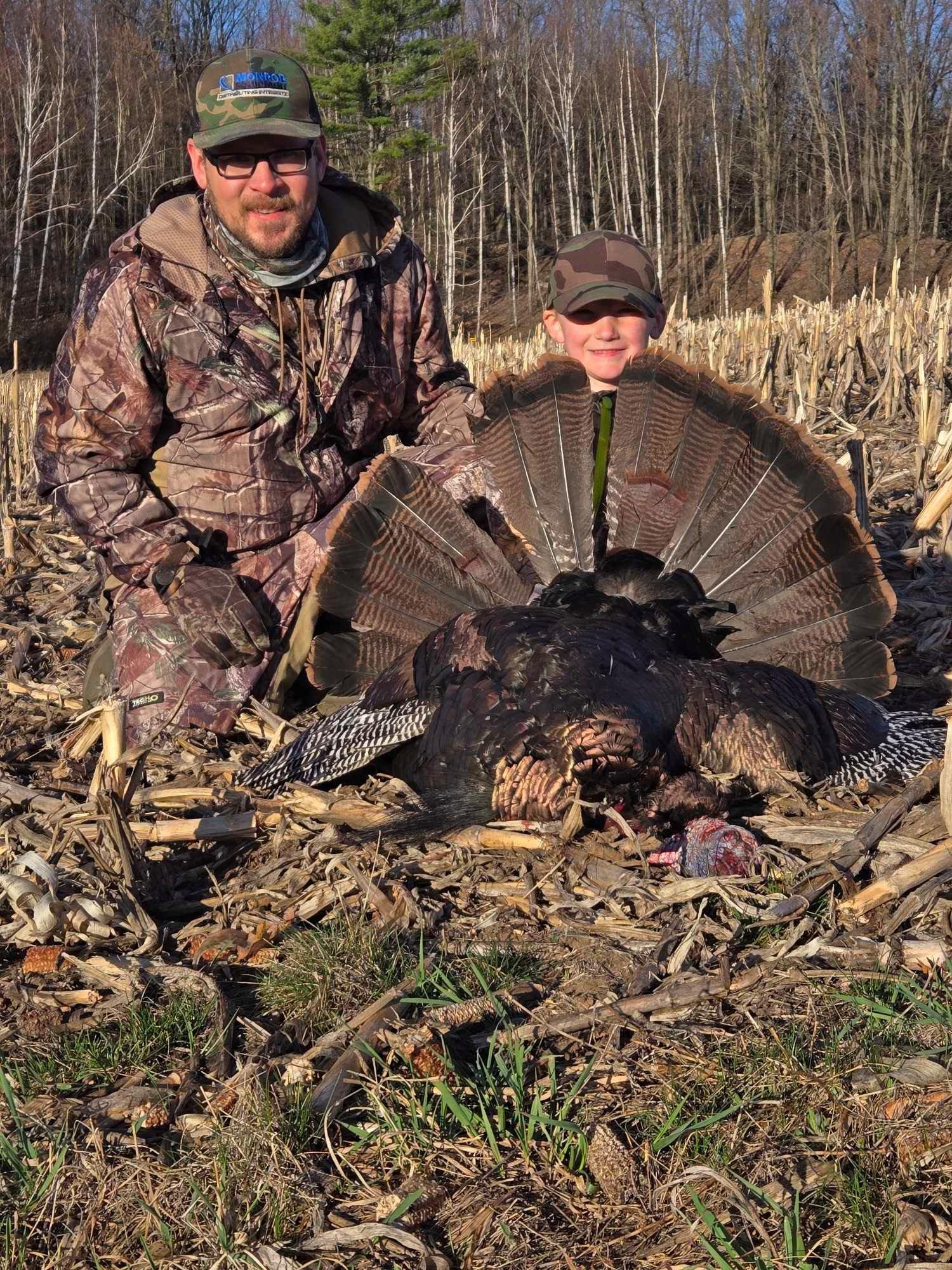Following an unusually mild winter, birds in the Northern tier of the United States are getting fired up, but henned up, too

Midwest turkey season looks promising as reports come in of abundant numbers and early season success. Image by John Hafner
I don’t know about you, but to me it feels like deer season just ended. Maybe it’s because the Midwest, where I live, experienced minimal snowfall and autumn-like temps nearly all winter. Regardless, here we are hunting April turkeys already.
Recently, I spoke with two of the NWTF’s district biologists; one covers the Dakotas, Minnesota, and Wisconsin, while the other covers Ohio, Michigan, and Indiana. Both gentlemen indicated that turkey numbers look good over all, and that hunting should be quite productive this spring. That outlook is already proving true as Midwest seasons kick off.

Mentor Jeremy Gollon (left) took young Sawyer turkey hunting during the Wisconsin youth hunt. On a morning hunt, this tom hung up 100 yards away for an hour, but aggressive calling brought the hens in, and the tom followed suit. (Photo courtesy of Jeremy Gollon)
A friend of a friend, Randy DuMez, and other mentors had some youth hunters out in Sheboygan County, Wisconsin, over the weekend.
“It was typical early-season turkey hunting with birds in larger flocks,” DuMez explained. “The toms responded really well from the roost, but they got quiet for a while on the ground. Then, they fired back up around 8-9 a.m. All of the toms seemed to be with hens. They responded to gobbles and jake yelps, but they wouldn’t leave the hens. We witnessed a big jake and tom fight that lasted for 10 minutes and also some breeding.
“On the second day,” DuMez continued, “I knew we needed to call in the hens, and that’s what we did. A hen came to the calls and decoys, and she pulled two toms right in with her. The boy we were mentoring missed, but his sister scored.”
Don’t Miss: 3 Classic Friction Calling Tricks to Try This Spring
Another Wisconsin mentor, Jeremy Gollon, also said that toms were henned-up during the youth hunt.
“I roosted seven toms the night before Sawyer’s (Gollon’s first mentee) hunt,” he said. “Six of them stayed in the woods after fly down, and all of them stopped gobbling on the ground. Sawyer’s bird gobbled one time when he reached the field. He strutted 100 yards away for an hour or so. I yelped very aggressively and started cutting back and forth with the hens, which got them worked up. The hens came to investigate, and he followed suit. As soon as he saw the 1/4-strut Avian-X LCD Jake decoy, he ran right in, and Sawyer took him.”

Sitting along a field edge in the afternoon amidst high winds paid off for Folton (right) and mentor Jeremy Gollon during the Wisconsin youth hunt. (Photo courtesy of Jeremy Gollon)
Winds picked up that afternoon when Gollon took a boy named Folton afield.
“We headed to another spot that I’d been scouting where a few toms consistently were hanging out,” he said. “We got set up at 5:30 p.m., and then we called every 20-30 minutes. Early on, six jakes came in. At 7 p.m., a tom came out of the woods from behind us at 20 yards, spitting and drumming. He never gobbled. Folton took him at 15 yards by the jake decoy.”
Out in western Nebraska, Scott Kuhn of Deer Meadows Outfitters said that birds are still in big flocks. “I haven’t seen any breeding yet,” he told. “The toms and jakes have separated, but I haven’t seen any fighting. The gobblers haven’t been responsive to calls yet, either.”

Hunters are already witnessing breeding behavior in the Northern U.S., as this recent trail camera image portrays. (Photo courtesy of Steve and Jason Halambeck)
Back East in Illinois, friend and fellow Realtree scribe Brian Lovett is currently out for the North Zone 1st Season. He said, “Bird numbers are good. The toms are pretty henned-up. The guy I’m hunting with missed a tom yesterday. In our camp, five birds have been killed so far (as of Tuesday morning), two of which are jakes. There are lots of jakes around. Today (Tuesday), the winds are high and hunting is tough.”
Don’t Miss: How To Turkey Hunt In The Midwest
A friend just texted me a series of trail camera photos of a Wisconsin tom breeding a hen with two jakes hovering to the side. And around home where I see turkeys daily, the dominant toms are keeping a close watch on the hens while satellite toms hover on the outskirts.
Across most of the Midwest, a few days of high winds and some precipitation will give way to nice weather for the weekend. For the next five to seven days, I expect gobbling to be most prevalent on the roost like it’s been so far, then peaking again around mid-morning. Toms will most likely be tied down with hens, but remember that satellites will be roving on the outskirts of flocks and could be susceptible to calls. Otherwise, you’ll have to call in the hens or set up along a flock’s daily routine.











